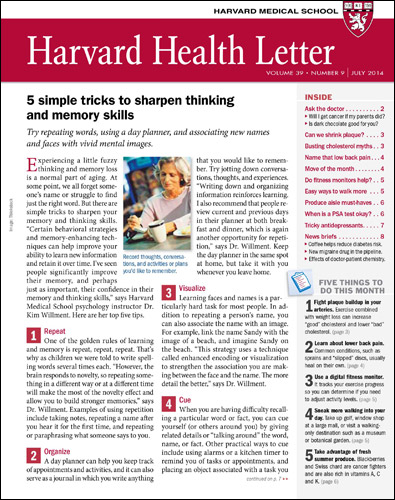Harvard Health Blog
Doctor groups list top overused, misused tests, treatments, and procedures

In a proactive effort to help stem healthcare spending, nine medical specialty organizations have published their top 5 lists of tests, treatments, or services that are unnecessary or at least should include a thorough conversation between patients and their doctors regarding the benefits and risks of before undertaking the procedure.
The lists are part of a campaign called Choosing Wisely, organized by the American Board of Internal Medicine Foundation. The medical societies, for example, advise against immediately prescribing antibiotics for sinusitis, ordering an MRI during the initial evaluation of back pain, and doing an exercise stress test for people who don’t have any signs or symptoms of heart disease. (See the top two “dont’s” from each specialty below, or visit choosingwisely.org to see all 45.) Eight more medical specialty organizations are planning to join the campaign.
The purpose of making these lists, says the foundation, is to help doctors and their patients talk about tests and procedures in order to choose the ones that:
- are supported by evidence
- don’t duplicate other tests or procedures
- are free from harm
- are really needed
Spending healthcare dollars wisely
In a recent article in the Journal of the American Medical Association, former Medicare administrator Dr. Donald Berwick and a colleague argue that as much as $900 billion dollars of health care spending is wasted each year. A big chunk of this comes from doctors ordering tests that yield little useful information or performing procedures that don’t make their patients better. This happens for several reasons. Some doctors just don’t know which procedures or tests are useful and which ones aren’t. Some order useless tests because their patients expect or ask for them. Others do it to protect themselves from possible lawsuits.
Take the exercise stress test as an example. It involves walking on a treadmill while monitors record the heart rate, heart rhythm, and blood pressure. It’s a useful test for people who have symptoms that might indicate heart disease, like chest pain when they are active or under stress. But as with many tests, it isn’t useful just to “check under the hood” in people who feel fine.
About 15% of the time, an exercise stress test suggests that there may be a heart problem, when in fact there isn’t. These “false-positives” can lead to needless worry and further testing, often including an invasive angiogram. To perform that test, a doctor must insert a thin wire and plastic tube called a catheter into a blood vessel in the groin and maneuver it into the heart. Angiogram-related complications aren’t rare.
And if the test shows a narrowing in an artery, many doctors and their patients are prone to fixing it with angioplasty and placement of a stent—which also can have complications and long-lasting repercussions—even though doing this won’t make the person feel better, protect him or her from having a heart attack, or live longer.
More isn’t better
Avoiding tests and procedures that aren’t effective or useful saves time and money, and protects the recipients from harm. For the Choosing Wisely campaign to be a success, all of us—doctors and their patients alike—must stop believing that if some medical care is good, more is better.
Top two “don’ts” from 9 medical specialty organizations
American Academy of Allergy, Asthma & Immunology
- Don’t perform unproven diagnostic tests, such as immunoglobulin G (IgG) testing or an indiscriminate battery of immunoglobulin E (IgE) tests, when evaluating a possible allergy.
- For uncomplicated acute sinusitis, don’t order sinus computed tomography (CT) or indiscriminately prescribe antibiotics.
American Academy of Family Physicians
- Don’t do imaging for low back pain within the first six weeks, unless red flags are present.
- Don’t routinely prescribe antibiotics for acute mild-to-moderate sinusitis unless symptoms last for seven or more days, or symptoms worsen after initial clinical improvement.
American College of Cardiology
- When initially evaluating patients who are not having cardiac symptoms, don’t perform stress cardiac imaging or advanced non-invasive imaging unless there are markers the patient is at high risk.
- Don’t perform stress cardiac imaging or advanced non-invasive imaging as part of routine follow-ups in patients without symptoms of cardiovascular disease.
American College of Physicians
- Don’t perform exercise electrocardiogram testing (exercise stress test) in patients who do not have any symptoms of heart disease and who are at low risk for coronary heart disease.
- Don’t obtain imaging studies in patients with non-specific low back pain.
American College of Radiology
- Don’t do imaging for uncomplicated headache.
- Don’t image for suspected pulmonary embolism (PE) without moderate or high pre-test probability.
American Gastroenterological Association
- When prescribing long-term acid suppression therapy for gastroesophageal reflux disease (GERD), choose the lowest dose of a proton pump inhibitor or histamine2 receptor antagonist to achieve therapeutic goals.
- Do not repeat colorectal cancer screening (by any method) for 10 years after a high-quality colonoscopy is negative in average-risk individuals.
American Society of Clinical Oncology
- Don’t use cancer-directed therapy for patients with a solid tumor who have the following characteristics: low performance status, no benefit from prior evidence-based interventions, not eligible for a clinical trial, and no strong evidence supporting the clinical value of further anticancer treatment.
- Don’t perform PET, CT, and radionuclide bone scans in the staging of early prostate cancer at low risk for metastasis.
American Society of Nephrology
- For patients on dialysis who have limited life expectancies, don’t perform routine cancer screening unless the patient has signs or symptoms of cancer.
- Don’t administer drugs that stimulate red blood cell production in patients with chronic kidney disease who do not have symptoms of anemia if their hemoglobin levels are greater than or equal to 10 g/dL.
American Society of Nuclear Cardiology
- Don’t perform stress cardiac imaging or coronary angiography in patients without signs or symptoms or cardiac disease unless they have other markers indicating they are at high risk for cardiac disease.
- Don’t perform cardiac imaging for patients who are at low risk.
About the Author

Patrick J. Skerrett, Former Executive Editor, Harvard Health Publishing
Disclaimer:
As a service to our readers, Harvard Health Publishing provides access to our library of archived content. Please note the date of last review or update on all articles.
No content on this site, regardless of date, should ever be used as a substitute for direct medical advice from your doctor or other qualified clinician.













